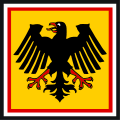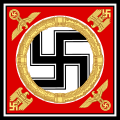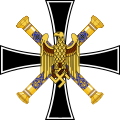Reich President - Simple English Wikipedia, the free encyclopedia
The Reich President (German: Reichspräsident) was the president (head of state) of the German Reich during the Weimar Republic (1919-1933) and Nazi Germany (1933-1945).
The Reich President was the successor of the German emperor. He had more power than the current Federal President (Bundespräsident).
The Reich President was elected for a seven-year term by the German people, and could be re-elected. He was the head of the army, appointed and relieved the Reich Chancellor (Reichskanzler), and could also send away the Reichstag.
The Reich President was supposed to exercise the legislative power with the Reichstag but due to the instable situation of the Weimar Republic, he was often bypassing the Reichstag by using special legislation. This was the case during the early years of the Reich Presidency and especially in the early 1930s. During the Hitler period the Reichstag was just show.
Presidents
[change | change source]Weimar Republic:
- Friedrich Ebert (1919-1925, SPD, died in office)
- Hans Luther (1925, no political party, acting)
- Walter Simons (1925, no political party, acting)
- Paul von Hindenburg (1925-1933, no political party, re-elected in 1932)
Nazi Germany:
- Paul von Hindenburg (1933-1934, no political party, died in office)
- Adolf Hitler (1934-1945, NSDAP, killed himself) [1]
- Karl Dönitz (1945, NSDAP, imprisoned)
Presidential Standards
[change | change source]- 1919–1921
- 1921–1926
- 1926–1933
- 1933–1934
- 1934–1945
- 1945
References
[change | change source]- Presidents and Assemblies, Chapter 4. Matthew Soberg Shugart, John M. Carey. Cambridge University Press. 1992.


 French
French Deutsch
Deutsch




